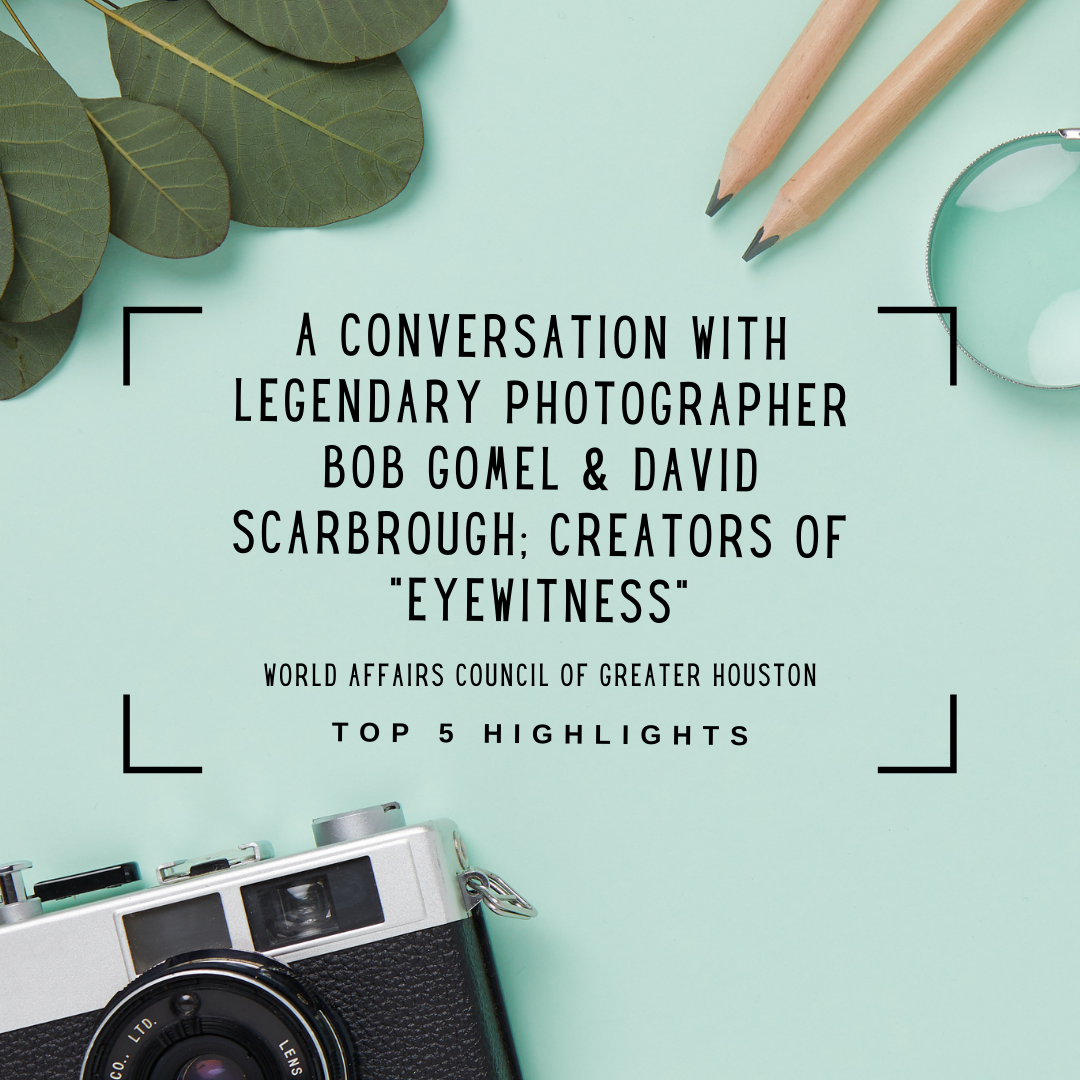– Joel Reyes
What do Dwight D. Eisenhower, The Beatles, Marilyn Monroe, and Ethiopia have in common?
They were all focal points of photographs captured by famous photojournalist and former professional photographer Bob Gomel. Gomel has had the opportunity to capture, represent, and eyewitness the essence of pivotal moments of American history, sports, and entertainment through his work as a Life magazine photographer. Through an interview conducted by the World Affairs Council of Houston on September 30th, 2020, Bob Gomel takes us through a glimpse of his career, the stories and inspiration behind some of his famous photographs, and even how the changes of photographic technology have influenced his creative and artistic approach. Additionally, details surrounding the film created to tell the stories behind some of Gomel’s famous works, titled “Eyewitness”, is discussed with director David Scarbrough.
Gomel’s introduction to photography
In the beginning of the interview, Gomel recounts the moment he knew that photography would be his life’s calling. Sometime in grade school, Gomel saw, in his teacher’s classroom, a portrait of a pigeon. This pigeon was resting on top of a manhole cover on a cobblestone street. Never before had Gomel been so impressed to see a picture that perfectly complemented the notions of intricacy and simplicity. Because of this one photograph, Gomel would dedicate the rest of his life to creating photographs of equal and greater caliber.
The inspiration for creating the documentary “Eyewitness”
The director, David Scarbrough, actually had a background in photography, similar to Gomel. Through connecting with mutual contacts and photographers, Scarbrough was able to properly meet Gomel. Captivated by his approachability and helpfulness, Scarbrough and Gomel established both a personal and professional rapport. One night, Scarbrough and Gomel had dinner with their respective spouses and conversation shifted towards how they could create another aspect of Gomel’s images. These discussions eventually culminated into a movie, titled “Eyewitness”.
Shot on only an iPhone 10 and with a minimalistic director’s approach, Scarbrough wanted to create an intimate environment where Gomel could thoroughly dive into the stories and moments leading up to some of his famous photographs. A goal for this newfound director centered on the audience; he wanted everyone who watched this movie to get something out of it that they did not have before.
A look at some pictures that never garnered traction until decades later (The Beatles, Malcolm X, and John F. Kennedy)
In a brief portion of the interview, Gomel takes us through three separate sets of photography that Life magazine, at the time they were taken, simply overlooked or did not find publishable at the time. It was through the course of time, decades later, that these pictures would resurface and be published for all to see. Some of them include The Beatles on vacation following their newfound rise to superstardom, and the meeting of civil rights pioneers Muhammad Ali and Malcolm X.
During his time with the Beatles, Gomel travelled with them throughout the United States, from New York to perform at The Ed Sullivan Show (twice) to Washington for a performance and even to Florida. Gomel took photographs of these stars during some downtime near the beach. A shot of the four lounging together on beach chairs would become well known and popularized. Gomel recalls them being humble, modest, and outgoing in taking direction from him.
Meanwhile, at the hotel where Malcolm X and Muhammad Ali would interact on camera, Gomel would not only be the only form of press allowed at the hotel, but be the only white individual there! Gomel recalls the energy in the room being nothing but comfortable. Seeing the joyous and celebratory mannerism of everyone there, Gomel found it very easy to capture the jubilant times from that night.
Gomel’s approach to photography
Gomel was not merely taking pictures of animals, or even his own family, but the most revered and famous individuals of the latter half of the 20th century. Because of this Gomel did not want to appear as a photographer who lacked genuine interest in his subjects. Before interacting with his subjects, Gomel took the time to do research on their backgrounds.
More specifically, he wanted to discover what interested or engaged his subjects the most. When he met with them, he would often guide the conversation to this point of engagement, creating moments of reflection and introspection. At this exact moment, Gomel would take the camera and capture the true essence of that person.
Advice for photographers of various proficiencies
Sporadically in the interview, Gomel drops various tips for those currently in photography and even for those who have never done it before. Gomel urges the photographer to move in close to the subject rather than far away. Furthermore, Gomel urges the photographer to exhaust every possible scenario and situation around the subject. What angles have I not tried? What kind of lighting is optimal for the situation? When is the best time of day to get this picture?
If one works the situation in every possible way and does not get the shot they wanted, Gomel insists to go back tomorrow and try again! In addition, Gomel explains that photography is not defined by the specific equipment one uses, but the passion, creativity, and “the burning in your gut”. In other words, to go into professional photography, one needs to be determined, passionate, and willing to analyze a situation in a multitude of ways.
This interview was only a surface level of some of the photographs Gomel has taken. For an even deeper dive into the history and stories behind some of his most popular works, check out “Eyewitness”, which can be purchased or rented on PrimeVideo.
To watch the interview with Ronan O’Malley, Bob Gomel, and David Scarbrough, visit the World Affairs Council of Greater Houston’s Youtube Channel using this link: https://www.youtube.com/watch?v=Z6cPaAJ5D4g&list=WL&index=9&t=261s

